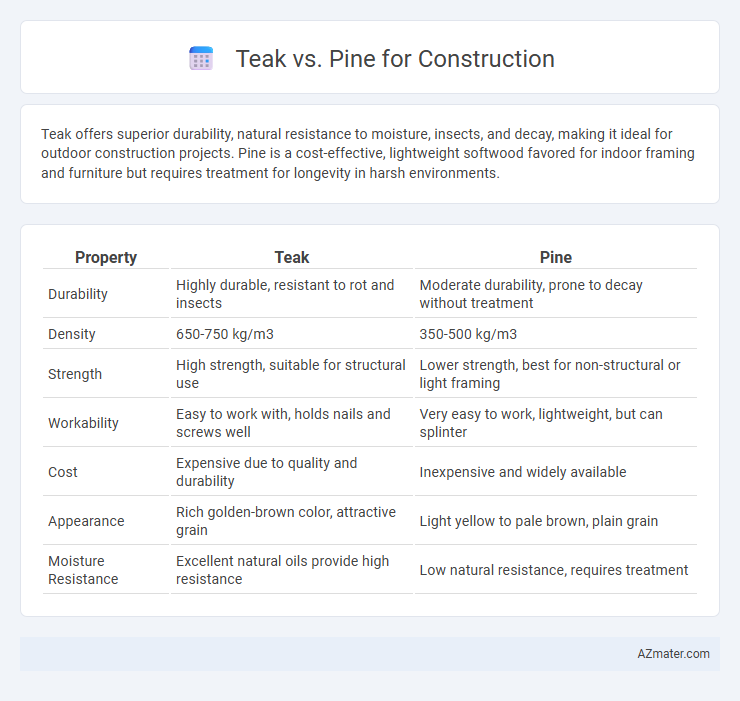Teak offers superior durability, natural resistance to moisture, insects, and decay, making it ideal for outdoor construction projects. Pine is a cost-effective, lightweight softwood favored for indoor framing and furniture but requires treatment for longevity in harsh environments.
Table of Comparison
| Property | Teak | Pine |
|---|---|---|
| Durability | Highly durable, resistant to rot and insects | Moderate durability, prone to decay without treatment |
| Density | 650-750 kg/m3 | 350-500 kg/m3 |
| Strength | High strength, suitable for structural use | Lower strength, best for non-structural or light framing |
| Workability | Easy to work with, holds nails and screws well | Very easy to work, lightweight, but can splinter |
| Cost | Expensive due to quality and durability | Inexpensive and widely available |
| Appearance | Rich golden-brown color, attractive grain | Light yellow to pale brown, plain grain |
| Moisture Resistance | Excellent natural oils provide high resistance | Low natural resistance, requires treatment |
Introduction to Teak and Pine in Construction
Teak is highly valued in construction for its exceptional durability, resistance to termites, and natural oils that protect against moisture and decay, making it ideal for outdoor and high-exposure applications. Pine, a softer wood, is commonly used due to its affordability, ease of working, and availability, but it requires treatment to withstand weather and pests. Both woods serve distinct roles in construction, with teak offering longevity and premium quality, while pine provides cost-effective versatility.
Key Characteristics of Teak Wood
Teak wood is renowned for its exceptional durability, natural oil content, and resistance to water, insects, and rot, making it a preferred choice for construction, especially in outdoor and marine environments. Its dense grain structure and high tensile strength ensure long-lasting stability and support under various climatic conditions. Compared to pine, teak requires less maintenance and offers superior longevity, justifying its higher initial cost in structural applications.
Key Characteristics of Pine Wood
Pine wood is a softwood known for its lightweight and easy workability, making it ideal for construction projects requiring rapid assembly. It features a pale yellow color with distinct grain patterns, offering good aesthetic versatility while maintaining moderate strength and durability. Pine's affordability and availability contribute to its popularity in framing, flooring, and interior woodworking applications.
Durability and Longevity Comparison
Teak wood exhibits superior durability and longevity compared to pine due to its high natural oil content and dense grain structure, which provide excellent resistance to moisture, insects, and decay. Pine, being a softwood, is more prone to denting, warping, and damage from pests, requiring regular treatment and maintenance to extend its lifespan. This makes teak a preferred choice for outdoor construction and heavy-use applications where durability and long-term performance are critical.
Strength and Structural Performance
Teak wood boasts superior strength and durability due to its high density and natural oils, making it highly resistant to warping, cracking, and insect attacks in structural applications. Pine, while lighter and more affordable, has lower compressive strength and is more prone to damage from moisture and pests, often requiring treatment for enhanced performance. For construction projects demanding long-term resilience and load-bearing capacity, teak offers better structural performance compared to pine.
Weather Resistance and Maintenance Needs
Teak wood offers superior weather resistance due to its natural oils and dense grain, making it highly resistant to moisture, decay, and insect damage, ideal for outdoor construction. Pine, while more affordable, requires regular treatment and maintenance such as sealing or painting to protect against weather elements and prevent warping or rotting. Choosing teak reduces long-term maintenance efforts and costs, whereas pine demands ongoing care to ensure durability in exposed environments.
Cost Analysis: Teak vs Pine
Teak wood commands a higher price due to its durability, natural resistance to pests, and attractive grain, making it a premium choice for construction projects that require longevity and aesthetic appeal. Pine, on the other hand, offers a cost-effective alternative with faster growth rates and widespread availability, significantly reducing upfront material expenses. While pine requires additional treatments to enhance durability, its affordability makes it suitable for budget-conscious construction without compromising basic structural needs.
Sustainability and Environmental Impact
Teak and pine differ significantly in sustainability and environmental impact for construction: teak is a slow-growing hardwood prized for durability, often sourced from selective plantations or illegal logging, raising concerns about deforestation and habitat loss. Pine grows faster and is generally more sustainable when harvested from well-managed forests, as it regenerates quickly and has a lower carbon footprint. Choosing certified wood like FSC pine supports reforestation efforts and reduces ecological damage compared to unsustainable teak harvesting practices.
Best Applications for Teak vs Pine
Teak excels in outdoor construction projects like decking, furniture, and boat building due to its natural oil content, durability, and resistance to rot and insects. Pine is ideal for indoor framing, trim, and cabinetry where cost-effectiveness and ease of workability are prioritized, despite its lower resistance to moisture and pests. Choosing teak for high-moisture or exposed environments and pine for interior, budget-conscious applications optimizes longevity and performance in construction.
Choosing the Right Wood for Your Construction Project
Teak offers superior durability, natural resistance to insects and moisture, making it ideal for outdoor construction and furniture requiring longevity. Pine is more affordable, lightweight, and easier to work with, suitable for interior projects or temporary structures where cost efficiency is a priority. Selecting the right wood depends on project requirements, environmental exposure, and budget, with teak excelling in durability and pine providing versatility and cost savings.

Infographic: Teak vs Pine for Construction
 azmater.com
azmater.com